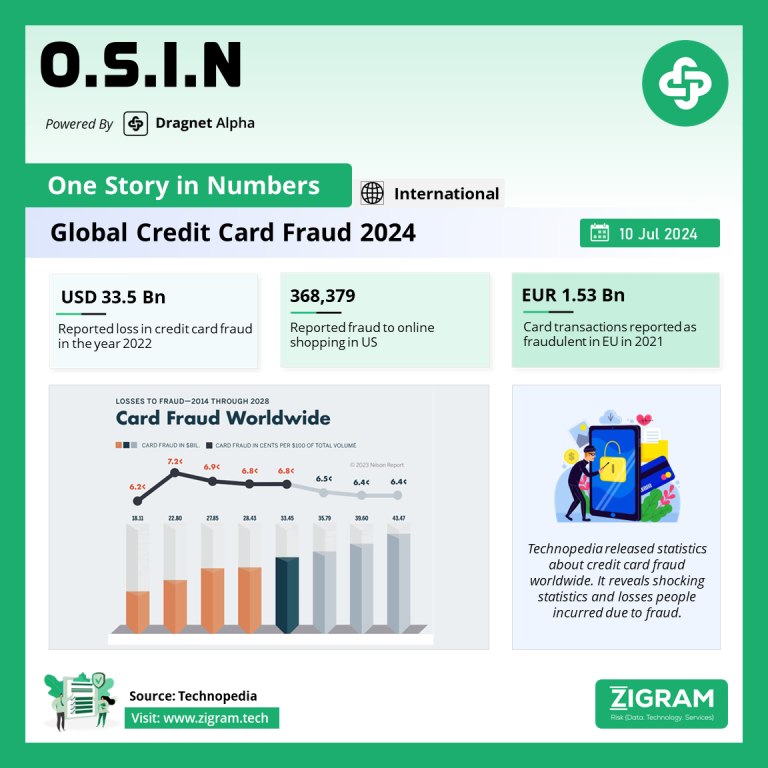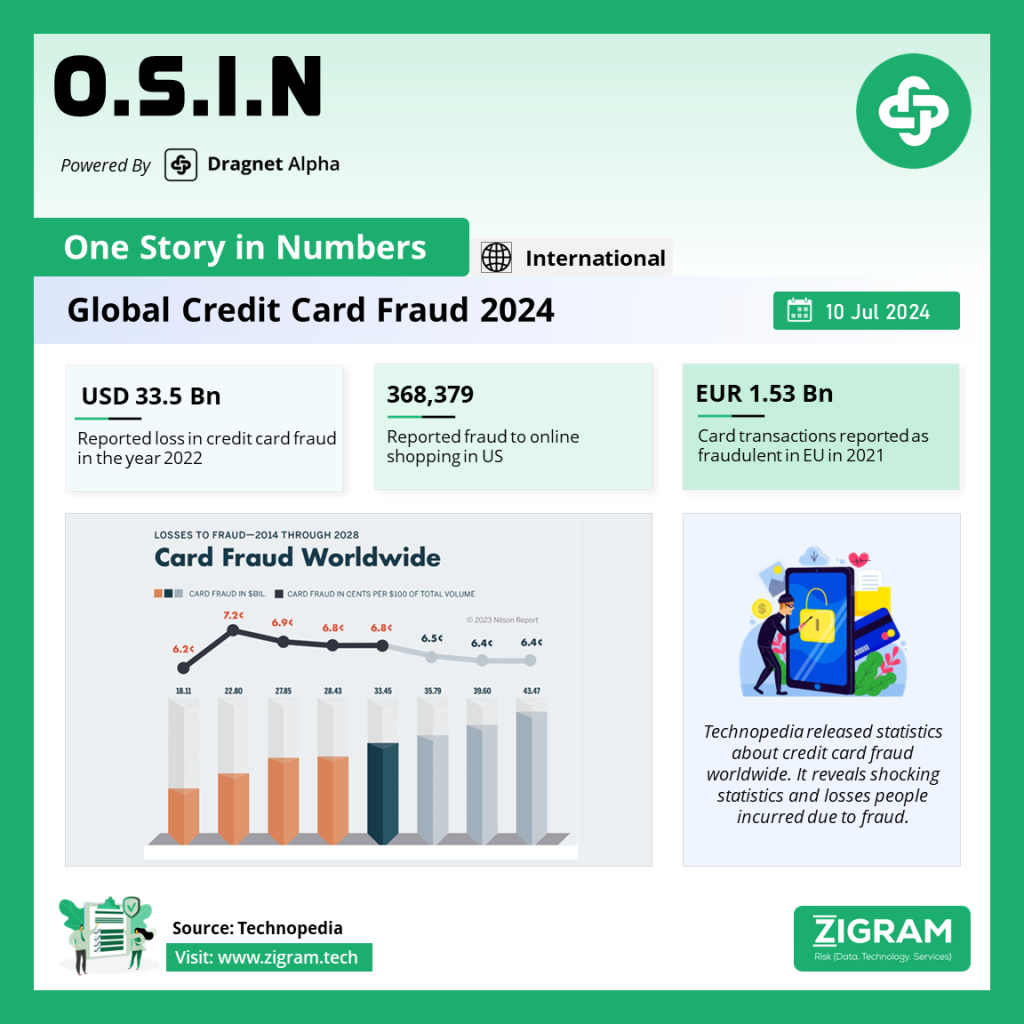Published Date:
Credit card scams, identity theft, and account takeover are just a few examples of the growing threats in today’s financial landscape. Understanding credit card fraud statistics and identity theft statistics helps highlight recent trends and underscores the importance of fraud prevention technology. This article from Technopedia delves into these issues, providing insights and statistics essential for protecting your money.
Key Takeaways
– In 2022, $33.5 billion was reported lost in card fraud worldwide, up from $28.4 billion in 2020 and $27.9 billion in 2018 (Nilson, 2023).
– In the EU, €1.53 billion in card transactions were reported as fraudulent in 2021, with a 7% decrease in the total number of fraudulent card transactions compared to 2020 (ECB, 2023).
– In 2024, 93% of fraudulent charges involved US credit cards that were still in the owner’s possession. This type of fraud, called card-not-present (CNP) fraud, amounted to $174 million lost in 2023 (Security, 2024; FBI, 2023).
– In 2023, consumers made 368,379 reports of fraud related to online shopping, resulting in $392 million in losses (FTC, 2023).
– As of the second quarter of 2023, 94% of global card-present transactions were conducted via cards with EMV chips, up from 92% in the same quarter of 2022 (EMVCo, 2023).
Annual Financial Impact
Understanding the annual financial impact of credit card fraud is crucial for businesses and consumers alike. Reviewing recent credit card fraud statistics helps us grasp the extent of the problem and highlights the importance of fraud prevention technology.
Estimated Global Losses
In 2022, $33.5 billion was reported lost in card fraud around the world (Nilson, 2023). This was up from $28.4 billion in 2020 and $27.9 billion in 2018. Meanwhile, the per-volume measure of fraud peaked in 2016 at 7.2¢ and then slightly decreased, staying around 6.8¢ through 2022 (Nilson, 2023). This means that in 2022, for every $100 spent, there was 6.8 cents worth of card fraud. Projections indicate it will continue to decrease to 6.4 cents by 2026 and 2028.
Ultimately, overall financial losses due to card fraud have been rising and are expected to keep going up, reaching $43.47 billion by 2028 (Nilson, 2023). Even though total fraud losses are increasing, the fraud rate per $100 of transaction volume has stabilized and is expected to drop slightly. This suggests that while the total number of fraudulent transactions is growing, better security measures or higher transaction volumes may be helping to control the relative rate of fraud.
Regional Breakdown
North America
In 2023, a total of $466 million were reported as fraudulent transactions made via credit or debit cards in the US (FTC, 2024). This amounted to a total of 197,785 reports of card fraud in 2023. In fact, in 2024, 60% of US credit card holders reported having had suspicious transactions on their cards at least once (Security, 2024). The total percentage of victims has dipped slightly since 2022 (65%), but the median expenditure per fraudulent charge spiked by 26% between 2022 and 2024 (from $79 to $100). This amounts to approximately $5 billion in criminal purchases yearly.
Europe
In the European Union (EU), €1.53 billion in card transactions were reported as fraudulent in 2021 (ECB, 2023). However, the value of card fraud dropped by 11% in 2021 compared with 2020. As a result, the share of fraudulent transactions among the total value of transactions also declined to 0.028% in 2021 from 0.036% in 2020. The total number of fraudulent card transactions in the EU reached 23.9 million in 2021 (ECB, 2023), down by 7% compared with 2020. Meanwhile, in the UK, 45% of financial fraud losses in 2022 were attributed to credit or debit card fraud (UK Finance, 2022). This amounted to roughly £540 million lost due to credit or debit card fraud.
Asia-Pacific
In 2023, $11.9 billion was recorded as credit card fraud in the Asia-Pacific region (APAC) (Nasdaq, 2024). This was the most popular type of payment fraud, followed by advance fee scams and check fraud. In fact, in 2023, 22% of fraudulent transactions were debit transactions, while another 25% of transactions were credit transactions (LexisNexis, 2023). Other types of financial fraud involved new payment methods (such as digital wallets, payment apps, etc. – 26%), as well as crypto (8%).
Latin America
The payment infrastructure in Latin America is often locally run, and credit card usage is less frequent, making fraud detection models used by banks weaker compared to other regions (Stripe, 2022). Additionally, local rules tend to favor cardholders in disputes, making businesses more vulnerable to fraud. In fact, the data show that between 2019 and 2022, Latin America had the highest card fraud rates in the world (Stripe, 2022). Businesses in Latin America had a 97% higher fraud rate compared to those in North America and a 222% higher fraud rate than businesses in the Asia-Pacific region. The market is also increasingly moving online, which creates more opportunities for fraud (Stripe, 2022). For instance, in 2021, there was a 518% increase in new businesses started on Stripe in Latin America, highlighting the growing online presence and the associated risks of fraud.
Types of Credit Card Fraud
Understanding the various types of credit card fraud is essential to grasp how common credit card fraud is and the number of people impacted by different types of fraud. Credit card fraud statistics from 2023 and 2024 show a range of methods used by criminals, from card-not-present fraud to identity theft and account takeover.
Card-Not-Present (CNP) Fraud
In 2024, 93% of fraudulent charges involved US credit cards that were still in the owner’s possession – they were not lost or physically stolen (Security, 2024). This is a type of fraud called card-not-present fraud (CNP), where criminals do not actually require a physical credit card to be able to charge a fraudulent transaction on it. In fact, there were 13,718 US reports of credit card or check fraud being conducted online (so without the physical presence of a card) in 2023 (FBI, 2023). This amounted to a total of $174 million being lost to CNP or check fraud in 2023. In the EU, the vast majority of card fraud was related to CNP transactions in 2021 (ECB, 2023). In 2020 and 2021, CNP fraud accounted for around 84% of the total value of card fraud, with the share growing steadily until 2020. The total value of CNP fraud in the EU amounted to €1.3 billion in 2021 (ECB, 2023). This marks a 12% decline compared with 2020.
Card-Present Fraud
Card-present fraud happens when fraudsters need the actual card to commit their crimes. Two common methods are skimming and cloning.
Skimming
Skimming involves using devices that steal card information. These devices are attached to real card readers at places like ATMs, gas station pumps, or store checkout terminals. When a card is swiped, the skimmer records the card’s magnetic stripe information. This data can then be used to make fake cards or unauthorized purchases.
Cloning
In the EU, the value of card-present fraud committed at ATMs amounted to around €74 million in 2021 (ECB, 2023). This marks a 4% decline compared with 2020. Furthermore, the value of card-present fraud committed at POS terminals amounted to around €177 million (ECB, 2023). This also marks a decline compared with 2020 (-7%). Overall, card-present fraud committed at ATMs and POS terminals in the EU declined in 2021 (-6% compared with 2020) (ECB, 2023). This follows a decrease of 28% in 2020 compared with 2019. The main type of EU card-present fraud recorded in 2021 continued to be losses from lost or stolen cards (ECB, 2023). Lost or stolen cards accounted for 88% of all ATM fraud and 56% of all POS fraud.
Identity Theft and Account Takeover
In 2023, credit card fraud was the most common identity theft type reported in the US (FTC, 2024C). The FTC received 416,582 reports from people who said that someone misused their information to open a new credit card account or to make changes to their existing credit card account without their permission. The majority of these reports related to new accounts (381,122 reports; down 7% compared with 2022) (FTC, 2024C). However, 44,855 reports related to existing accounts, a 14% increase compared with 2022. Furthermore, the majority of identity thefts related to credit cards were reported by people aged 30-39 years old (FTC, 2024C). This age group recorded 122,246.
Read the full article here.
- #CreditCardScam
- #IdentityTheft
- #AccountTakeover
- #FraudPrevention
- #CardNotPresentFraud
- #CyberSecurity
- #FinancialFraud
- #CardFraud
- #DataBreach
- #SecurePayments
- #DigitalSecurity
- #EMVChip
- #OnlineFraud
- #Skimming
- #Cloning
- #ConsumerProtection
- #FraudAwareness
- #ProtectYourData
- #ScamAlert
- #AntiFraud

